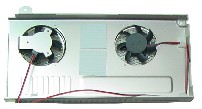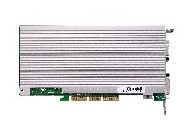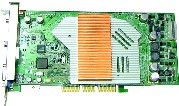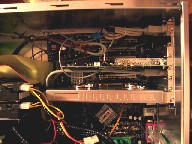With the WinFast A350 TDH MyVIVO, Leadtek offers a great blend of features and performance for a price below many of its FX 5900 competitors. Read the review to see if this graphics board should be on your list of choices for your next upgrade.
Introduction
When I see a graphics board that costs around $400, I always wonder what I would get for the $150 to $200 price premium over what I would pay for an equivalent mid-range board. Thanks to Leadtek, I can stop wondering. I recently reviewed the Leadtek WinFast A310 Ultra TD MyVIVO, which is based on NVIDIA’s GeForce FX 5600 GPU. Obviously, this makes it a mid-range board. Leadtek was kind enough to supply Bjorn3D with their WinFast A350 TDH MyVIVO, one of their high-end video cards based on NVIDIA’s GeForce FX 5900 GPU.
However, before I compare these two graphics boards from Leadtek, in the usual Bjorn3D fashion, I am going to show you what kind of out-of-the-box experience you can expect if you were to purchase the WinFast A350 TDH MyVIVO. Then, we can take a look at what kind of performance improvement you can get from spending the extra money. Considering the graphics core clock is bumped from 350 MHz to 400 MHz and the memory clock from 700 MHz to 850 MHz to go from the A310 to the A350, I think we can expect a lot from the A350.

The two big circles in the picture above are the left intake fan and right output fan. They are part of Leadtek’s TwinTurbo-II Cooling System. This cooling system is Leadtek’s attempt to differentiate this card from the numerous competitors in the graphics card market. I’m hoping this will allow me to overclock the GPU and memory clocks to make this card perform closer to the even higher priced FX 5900 Ultra boards on the street. Read on to find out!
Specifications & Features
Specifications:
I listed what I think are the most interesting specs for the WinFast A350 TDH MyVIVO, but you can go to Leadtek’s website to get more details about this card.
- Powered by NVIDIA’s 0.13 micron GeForce FX 5900 GPU
- NVIDIA CineFX 2.0 engine for true 128-bit precision processing
- 2nd-generation Intellisample high-resolution compression technology (HCT)
- nView Multi-display Technology
- 256-bit Memory Interface with Advanced Memory Control
- DVI support – for resolutions up to 1600×1200
- Integrated TV Encoder – provides TV-out functionality for resolutions up to 1024×768
- WinFast TwinTurbo-II Cooling System
- Performance:
- 400 MHz RAMDACs
- 128 MB DDR SDRAM
- Graphics Core: 256-bit
- Graphics core clock: 400 MHz
- Memory Interface: 256-bit
- Memory Bandwidth: 27.2 GB/sec
- Fill Rate: 3.6 billion texels/sec
- Vertices/sec: 338 million
- Memory Clock: 850 MHz
- Maximum pixels per clock: 8
- Textures per pixel: 16
Features:
Software Bundle:
- Ulead VideoStudio 7 SE DVD
- Ulead DVD MovieFactory 2 SE
- Ulead COOL 3D SE
- WinFast PVR
- WinFast DVD
- WinFox II
- Cult 3D
- Coloreal Embedded
- Coloreal Visual
- Coloreal Bright
- Gun Metal
- Big Mutha Truckers

- Picture-in-picture: One for “live” program and the other for a captured program. The main and sub program can be switched, and the sub screen video can be displayed anywhere on the desktop in any size.
- De-interlace: Improves quality for fast-motion video. No noise and flicker on the edge of motion objects.
- Video Capture: Supports MPEG1/MPEG2/MPEG4 and VCD/DVD/WMV formats for video caputure and MP3/WMV audio recording.
- Direct Burn: Capture video directly from external video devices to DVD, saving time and hard drive space.
TwinTurbo-II Cooling System:
The TwinTurbo-II Cooling Systems is a unique cooling solution that completely surrounds the video card in an aluminum casing. The complete system is shown in the pics below. There are two fans in the front, as you can see in the first picture, to provide steady airflow over the chips and heatsinks hidden behind the front cover. As you can see in the third picture, each of the memory chips and the GPU are covered in heatsinks to pull heat away from them. It seems as if this should be a very good cooling system for the FX 5900. Unfortunately, it makes the card heavy (the heaviest card I’ve ever held) and rather large. I remember wondering what was in the box when the package was delivered to me, and I was surprised that it was only the graphics board package! The video card with the aluminum casing measures in at a portly 8.5″ (21.5cm) x 0.875″ (2.25cm) x 4″ (10cm). This could make it difficult to install in certain systems (more on this later).
 Front view of the TwinTurbo-II. |
 Inside of the front part of the casing. |
 Back view of the cooling system. |
 This is what’s under the hood. |
Package Contents
Those of you who read my review of the WinFast A310 Ultra TD MyVIVO may be looking at the picture below and thinking the bundle looks familiar. Well, if you are, you’re right. This appears to be Leadtek’s standard bundle for their MyVIVO line of cards. They give you all the essential video cables to make their MyVIVO solution work, and that’s about it.
Besides the A350 and the software CDs mentioned on the previous page, here is what is in the box:

The software bundle for the WinFast A350 TDH MyVIVO is nearly identical to the bundle Leadtek provides with the WinFast A310 Ultra TD MyVIVO. In the interest of eliminating repetition, I am not going to cover the software in this review. Instead, I invite you to check out this page of my review of the WinFast A310 Ultra, where I briefly covered each of the bundled applications. There are a couple important differences in the A350‘s bundle, though. It includes a later version of VideoStudio, and it includes DVD MovieFactory 2, which is not included in the A310‘s bundle.
Installation
Unfortunately, the installation of the WinFast A350 was more of chore than a video card installation should be. The large size of the TwinTurbo-II Cooling System can certainly be an impediment to installing this graphics board in smaller systems and even some “average” mid-tower systems such as mine. However, I think Leadtek is only partially at fault for the problem I had. My motherboard’s manufacturer, AOpen, is the other responsible party. The combination of a poorly placed, large capacitor and the large size of the aluminum cooling solution employed by Leadtek prevented the WinFast A350 from being fully inserted into the AGP slot on AOpen’s AK79D Max, which I reviewed a few months ago. The end of the aluminum casing was sitting right on top of the rather tall capacitor, and this prevented the card from being inserted completely into the slot. It wouldn’t even go in far enough to allow the PC to boot!
 The cap closest to the IDE connectors is the culprit. |
 The card installed in my PC. |
As you can tell from the second pic above, I eventually managed to make this card fit on the motherboard. In order to accomplish this, I had to take the front cover off the aluminum casing and install the video card with this being held loosely on the board. The front cover of the TwinTurbo-II is normally fastened to the board with a screw and a plastic peg. Taking these off allowed the front part of the casing to move up (away from the motherboard) a little bit when the large capacitor hit it, which allowed the card to be completely inserted into the AGP slot. Unfortunately, this will not work as a permanent solution because I cannot set my PC back up in its normal vertical position without the chance of that front piece falling off since it is not really fastened to the board. For a permanent fix, I suppose I could either cut a small piece out of the aluminum casing or put a small dent in it so that the motherboard’s capacitor can slip nicely up into it. Actually, a better solution would be to get a different motherboard. 😉 On a serious note, I would strongly advise anyone who may consider buying this graphics card to check if their motherboard has a capacitor or anything else relatively tall near the AGP slot. Hopefully, this would prevent anyone from purchasing this card only to find out that it will not fit in their system.
Performance
Here’s what a lot of you have been waiting for, or maybe you just skipped to this page. (Seriously, if you did skip to this page and you’re considering buying this video card, you should read about my installation experience on the previous page. You’ve been warned.) For those of you looking for details on the MyVIVO functionality of the WinFast A350 TDH MyVIVO, please check out this page in my WinFast A310 Ultra TD MyVIVO review. I am not covering that functionality in this review since the two cards offer the same VIVO features.
What I am covering in this review is a lot of benchmarks comparing the two cards from Leadtek. Keep in mind that the A310 series of boards is based on the GeForce FX 5600 GPU; whereas, the A350 series utilizes FX 5900 GPUs. Any video card based on the FX 5900 should thoroughly outperform any card based on the FX 5600. With a plethora of benchmarks – 3DMark2001 and 3DMark03, Comanche 4, Gun Metal, and Unreal Tournament 2003 – we will be able to see just how well the A350 can outpace the A310. But first we should look at a comparison of these boards to see what we should expect.
| A310 Ultra & A350 Comparison Chart | ||
| Video Card | A310 Ultra | A350 |
| Core Clock | 350 MHz | 400 MHz |
| Memory Clock | 700 MHz | 850 MHz |
| Memory Bus Width | 128-bit | 256-bit |
| Maximum Pixels/clock | 4 | 8 |
| Fill Rate (texels/sec.) | 1.4 billion | 3.6 billion |
| Vertices/sec. | 88 million | 338 million |
| Memory Bandwidth | 11.2 GB/sec | 27.2 GB/sec |
From looking at the table, I would expect a lot from the A350 when compared to the A310 Ultra. The bottom three rows in the table represent theoretical performance for these boards. The A350 more than doubles the numbers of the A310 Ultra in all of these theoretical values, and the 150 MHz jump in memory clock and the 256-bit memory bus width are two of the main causes of this increase. Looking at the numbers makes me think the A350 with its FX 5900 GPU should perform at least 50% better than the A310 Ultra with its FX 5600 Ultra GPU in all benchmarks, especially the more stressful benchmarks such as 3DMark03 and Gun Metal. And I wouldn’t be surprised if the A350 does not often double the performance of its little brother. I would actually be disappointed if doesn’t. So, let’s get on with the benchmarks…
But first, I need to show you the test system specs:
Test System:
- AOpen AK79D Max
- AMD Athlon XP 2000+ (retail w/ stock HSF)
- 512 MB Corsair XMS PC2700 DDR-SDRAM (CMX512-2700C2)
- Western Digital 80GB ATA/100 HDD (8MB Buffer – WD800JB)
- PlexWriter PX-W1610A (16x/10x/32x) CD-RW drive
- NVIDIA Detonator Drivers 44.03
- Microsoft Windows XP (SP1)
Also, I think it is important to note that I have the “Image Settings” slider in the driver set to “Quality,” and DirectX 9.0a is installed.
3DMark03 (v 3.2.0)
Even though we have not really embraced 3DMark03 here at Bjorn3D (due to the controversy that surrounds it), I felt that some readers might want some scores as a reference since it utilizes current high-end graphics hardware features, such as pixel and vertex shaders. Also, since I’m comparing two video cards based on chips from NVIDIA, I don’t think the controversy is very relevant in this case.
|
||||||||||||
|
|||||||||
The FX series of GPUs from NVIDIA is basically known as the series that performs best when stressed with demanding features like anti-aliasing (AA) and anisotropic filtering (AF) enabled. As we can see in the above chart, the higher-end FX-based graphics boards can be expected to increase their performance lead over their siblings even more when AA and AF are enabled. Without AA and AF enabled the A350‘s 3DMarks total is about 67% greater than that of the A310 Ultra. That is respectable, but what really makes a statement is the 80% increase in performance the A350 offers when AA and AF are enabled. This is exactly what we should expect from a high-end, pricey piece of hardware. This basically means that the A350 takes less of a performance hit when AA and AF are enabled.
3DMark2001 SE (Build 330)
This chart and each one after this one show us the differences in performance hit when increasing resolution and when enabling AA and AF.
|
|||||||||||||||||||||||||||||||||||||||||||||||||||||||||||||||||||||||||||||||||||||||||||||||||||||||||||||||||||||||||||||||||||||||||||||||||||||||||||||||||||||||||||||||||||||||||||||||||||||||||||||||||||||||||||||||||||||||||||||||||||||||||||||||||||||||||||||||||||||||||||||||||||||||||||||||||||||||||||||
|
|||||||||||||||||||||||||||
With 3DMark2001 running with AA and AF both disabled, the A350 does not quite enjoy the lead it had in 3DMark03. However, once the GPUs start getting seriously taxed with AA and AF, the A350 regains its near doubling of the A310 Ultra‘s performance at the two higher resolutions. I wonder if this trend will continue in actual game benchmarks. Read on to find out.
Performance
UT2K3 Demo (HardOCP UT2K3 Bench v2.1)
Due to the recent controversy about NVIDIA’s 44.03 drivers, I have decided not to do the usual “4xAA, 8xAF” set of tests with UT2K3. Instead, I have replaced that with an “8xAA, NoAF” test. Although this does not stress the boards nearly as much, I decided it was the next best thing and avoids controversy at the same time.
The tables below show the results from the Antalus and Asbestos maps.
|
||||||||||||||||||||||||||||||||||||||||||||||||||||||||||||||||||||||||||||||||||||||||||||||||||||||||||||||||||||||||||||||||||||||||||||||||||||||||||||||||||
|
|||||||||||||||||||||||||||||||||||||||||||||
This is quite an impressive showing once again for the A350. As the stress level of the tests increases, the A350 increases its performance lead over the A310 Ultra. This time it reaches near double the performance of the A310 Ultra in the third test, and it maintains or gains on that lead for the rest of the tests.
Comanche 4
|
||||||||||||||||||||||||||||||||||||||||||||||||||||||||||||||||||||||||||||||||||||||||||||||||||||||||||||||||||||||||||||||||||||||||||||||||||||||||||||||||||
|
|||||||||||||||||||||||||||
This chart tells a story similar to the told by the UT2K3 chart, so there’s really nothing to add about this one.
Gun Metal (v1.20s) Benchmark 1
Yeti Studio’s Gun Metal is one of the few DirectX 9 games on the market right now. That may seem surprising to some, considering its console roots. Nonetheless, this game provides a good benchmark for current DirectX 9 performance. Considering the fact that DirectX 9 support is one of the compelling reasons to upgrade to an FX series video card, this test should give us an idea of how these boards can handle the upcoming generation of PC games. Check out more information on how Gun Metal utilizes DX9 over at NVIDIA.com.
|
|||||||||||||||||||||||||||||||||||||||||||||||||||||||||||||||||||||||||||||||||||||||||||||||||||||||
|
|||||||||||||||||||||||||||
Once again, the A350 comes through with the performance I expected – it more than doubles the performance of the A310 Ultra on every test this time! I’m really starting to think you get what you pay for with the A350 and other FX 5900 boards.
Overclocking
I was able to take this video card’s core clock and memory clock up to 436 MHz and 922 MHz, respectively. That’s a nice boost, especially in the memory clock. In order to see how much performance increased with these new frequencies, I re-ran one Gun Metal and one UT2K3 benchmark. For those interested in temperatures, my idle ambient and GPU core temperatures were usually around 38 degrees Celsius and 48 degrees Celsius, respectively, according to the reading in the driver utility. After running benchmarks, the temperature usually crept above 60 degrees, but I did see it near 80 occasionally. That’s getting pretty hot, and I have to wonder if the TwinTurbo-II cooling system not being completely sealed (please read my installation notes if you don’t know what I’m talking about) is at least partially culpable for this.
UT2K3 – Antalus
|
||||||||||||
I really expected more of an improvement from such a jump in memory and core clock speeds, but I guess we have to settle for less that 3 FPS in Unreal Tournament 2003. I also played the game with 4 bots on Antalus at the same settings, and it felt like I was getting better than 40 FPS because I didn’t notice any choppiness, even with sound on, albeit on low quality. So, the numbers might not be too impressive, but the game felt smooth and played well with these settings.
Gun Metal Benchmark 1
|
||||||||||||
Gun Metal appears to have produced the same lackluster increase in performance. However, once we look at the numbers, the increase in performance is actually more than I expected. The core clock frequency was increased by 9% and the memory frequency was increased by about 8.5%, and this resulted in an increase in FPS of about 13%. That’s actually quite good.
Conclusion
Obviously, the Leadtek WinFast A350 TDH MyVIVO is a stellar performer, and it easily outperforms its little brother, the WinFast A310 TD MyVIVO, as it should. No one would deny that or expect any differently. That is why I want to stress today’s prices for these boards. A search on PriceGrabber reveals that the current lowest price of the WinFast A350 TDH MyVIVO is around $355, and the WinFast A310 TD MyVIVO can be had for around $195, which is about $25 cheaper than when I reviewed it about six weeks ago. OK, I know that even spending near $200 for a graphics boards seems crazy to some people, but for those who can afford it, the extra $160 dollars to upgrade to the FX 5900 offering from Leadtek would be well worth it. For less than twice the price of the A310 Ultra, you can achieve more than twice the performance with the A350. Not too shabby. But, what about the Radeon 9800 Pro? Can’t we get that for even less hard-earned cash? Actually, no, the 9800 Pro should cost around the same price (at least for a retail version, which is what we should compare here). Another quick look on PriceGrabber reveals that it is about the same price as the WinFast A350 TDH MyVIVO. So, now it really can be a choice of which chip or company (NVIDIA or ATI) you like better.
Even without comparing the WinFast A350 TDH MyVIVO to another card in Leadtek’s A3xx family, the A350 is a great product. Leadtek provides a great package for people who want to capture video and burn it to DVD or CD and for people who want to have a home theatre PC that can be used as a PVR or to play games on a big screen monitor or TV. Even though I had some issues with the TwinTurbo-II cooling system on the board, it is innovative and seems to be effective. I never experienced any stability problems with this board, and I was able to overclock both the memory and core clock by around 9%. I still strongly encourage anyone who is considering purchasing the WinFast A350 TDH MyVIVO to check the layout of your motherboard to make sure nothing could get in the way of this large graphics board.
With next generation games right around the corner and people looking to buy a graphics board, Leadtek comes through with an aggressively priced (relative to other FX 5900 solutions), full-featured graphics board in the WinFast A350 TDH MyVIVO.
Final Score
| Performance |
9
|
The A350 met all my performance expectations and then some. And it performs well in VIVO functionality as well. |
| Features |
9
|
The MyVIVO features are top-notch, with features like Direct Burn and Picture-in-Picture. The cooling system on this board is a bit large, but it is effective and did not make my PC any louder than it already was. |
| Bundle |
9
|
People who plan to use all the MyVIVO features in this package should have all the software they need, even DVD authoring tools. And Leadtek throws in a DirectX 9 game, Gun Metal. It may be a console port, but it is one of the few DirectX 9 games out right now. |
| Quality |
8
|
The board and its cooling system seem very well built. The A350 just feels and looks like a high-end graphics board. However, I had problems with the installation due to its size, and I fear that others might experience the same problem. |
| Price / Value |
8
|
Even though the prices on high-end video cards usually make them available only to the most affluent consumers, some cards stand out as true deals. I believe the A350 is one of these deals. It is one of the lower priced FX 5900 solutions available right now, even with its plethora of VIVO features and innovative cooling solution. |
| Final Score: 8.6 | ||
I’m awarding the Leadtek WinFast A350 TDH MyVIVO an 8.6 out of 10 and the Bjorn3d Seal of Approval!
 Bjorn3D.com Bjorn3d.com – Satisfying Your Daily Tech Cravings Since 1996
Bjorn3D.com Bjorn3d.com – Satisfying Your Daily Tech Cravings Since 1996




